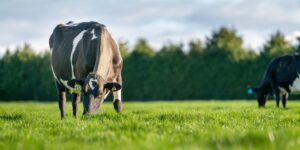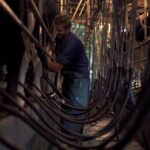Head vs. Heart: Farmers Decide Fonterra’s Mainland Future
Words by Richard Williams
Fonterra’s Mainland Group divestment promises to be a defining vote for farmers.
Fonterra’s shareholders are currently being asked to make one of the most significant decisions in the co-operative’s history, whether to approve the $4billion sale of its consumer and associated businesses to Lactalis, the world’s largest dairy group.
If the sale is approved, Fonterra is targeting a tax-free capital return of $2.00 per share. For a typical farm producing 100,000 kilograms of milk solids each year, that equates to a $200,000 payout. The co-operative also expects to maintain attractive dividends and a strong balance sheet moving forward, with a goal of returning to pre-sale levels of profitability within three years.
The proposal seems well placed to create lasting value for farmers and for Fonterra as a co-operative, and yet with only days to go before voting closes on 30 October, many farmer shareholders remain undecided.
As Fonterra Chair Peter McBride observed in a recent Farmers Weekly article, “It’s a case of farmers’ heads fighting with their hearts”. Farmers are clearly weighing the emotional loss of legacy brands like Mainland and Anchor against the tangible economic benefits the sale promises to deliver.
Let’s look at the facts.

What is the Mainland Group divestment?
The proposed sale would see Fonterra separate and sell its global consumer business and several integrated regional operations. This includes household brands such as Mainland, Anchor, Kāpiti, Fresh’n Fruity and Primo, as well as processing operations in Australia and Sri Lanka.
Under long-term supply agreements, Fonterra will continue to supply raw milk to the divested businesses for at least the next decade and dairy ingredients for a minimum of six years. Lactalis, if the sale proceeds, will become one of Fonterra’s largest customers.
The divestment represents a major structural change, positioning Fonterra as a more streamlined, farmer-focused co-operative, centred on milk collection, ingredient innovation and global foodservice markets.
Why Fonterra wants to sell
For Fonterra, this is a numbers-driven decision. The divestment allows the co-op to release capital back to shareholders while sharpening its focus on areas that generate stronger long-term returns. The board’s position is that concentrating on the Ingredients and Foodservice sectors will create greater value for shareholders than continuing to invest in the consumer business.
Over the past decade, the consumer division has faced mounting competition, rising costs, and slimmer margins. Fonterra’s consumer business takes up about a quarter of the co-op’s capital but brings in less than one-fifth of its profits, well below the returns from Ingredients and Foodservice.
The case for the sale
Supporters see the divestment as a strategic decision rather than a retreat. They argue that selling the consumer arm allows Fonterra to double down on its global strengths in dairy Ingredients and Foodservice, sectors where the co-op has long been a world leader. By concentrating resources on high-yield business-to-business channels, Fonterra expects to deliver stronger, more consistent returns over time.
The sale also unlocks significant capital for shareholders. Selling a non-core business provides funds for a meaningful capital return and strengthens the balance sheet, a rare opportunity for farmers to directly benefit from a strategic move. With milk prices already strong, the proposed capital return would put many farmers in a uniquely positive position, providing additional options to reinvest in their businesses, reduce debt, or strengthen succession plans.
Economists note that the proposed capital return could provide a welcome boost to rural confidence and investment. With milk prices already strong, a one-off payout of this scale would strengthen on-farm balance sheets and inject fresh liquidity into rural communities. Analysts suggest that many farmers may use the funds to pay down debt, invest in productivity improvements, or support succession planning — all of which help stabilise the wider rural economy. While unlikely to transform the national outlook on its own, the injection of several billion dollars into provincial regions would be a timely confidence lift for both farmers and the agribusiness sector that supports them.
Fonterra also points to simplification. Managing large consumer portfolios across multiple markets has added complexity, cost, and exposure to retail volatility. Streamlining the business will reduce that administrative burden, improve efficiency, and allow management to concentrate capital and resources on areas that deliver more consistent returns. In essence, Fonterra will move from being a broad, consumer-facing enterprise to a more focused, business-to-business dairy exporter built around scale, specialisation, and efficiency.
The case against the sale
Critics take a different view. For them, the divestment represents the loss of a proud legacy, the selling of brands built by generations of Kiwi farmers and recognised around the world. For many, the thought of foreign ownership of brands like Anchor and Mainland feels deeply unsettling, raising questions about New Zealand’s dairy identity and long-term control over its food production story.
Opponents also warn that without its consumer division, Fonterra could become more exposed to global commodity price swings. The branded business has historically provided a degree of insulation against downturns in ingredient pricing. Once sold, re-entering that market would be both difficult and expensive.
While the supply agreements provide certainty for both Fonterra and the divested Mainland Group in the short term, some risks remain. Farmers and the co-op will continue to rely heavily on a single major customer, which could be affected by changes in demand, operational priorities, or ownership decisions. Fixed terms in the contracts may limit flexibility to respond to market fluctuations, coupled with renegotiation after the agreements expire (and the risk they won’t be renewed) could bring uncertainty. While the agreements offer stability for now, they do not eliminate exposure to market, operational, or strategic risks.
It remains to be seen if Winston Peters’ recent warning is accurate, that the divestment might deliver a quick cash boost while risking longer-term strategic setbacks.
What it means for farmers
For Fonterra’s farmer-shareholders, the decision carries both short-term rewards and long-term implications. In the short term, the capital return would represent a significant cash injection, likely the largest since Fonterra’s formation, strengthening on-farm balance sheets and rewarding loyalty to the co-op.
In the medium term, the co-operative’s focus will narrow to milk price performance, ingredient returns and global foodservice growth. Its success will depend on operational efficiency and the ability to create higher-value products from New Zealand milk.
In the long term, Fonterra’s identity may evolve from a vertically integrated dairy exporter to a leaner, specialised ingredients powerhouse. Whether that makes the co-op stronger or more vulnerable will depend on market conditions, execution, and how well it retains the trust and engagement of its farmer base.
What it means for Taranaki farmers
The divestment’s impact on Taranaki will be closely watched. The region is home to one of Fonterra’s largest processing plants and a strong concentration of supplier farms, meaning any change in the co-op’s structure or strategy is felt locally and immediately. While the sale itself is unlikely to disrupt milk collection or processing in the short term, with long-term supply agreements in place, it could gradually reshape how milk from the region is channelled and valued. For many Taranaki farmers, the capital return will provide additional financial flexibility, while the long-term effects will depend on how Fonterra reinvests in its core Ingredients and Foodservice operations within the region. If executed well, the move could reinforce Taranaki’s role as a cornerstone of high-value dairy production rather than a base for consumer-brand manufacturing.
A pivotal decision
For many, this vote is about more than balance sheets and dividends, it’s about what kind of co-operative Fonterra wants to be. Supporters see it as a logical evolution: returning to Fonterra’s roots as a farmer-led exporter focused on scale and efficiency. Sceptics see the potential loss of a deep and valuable link between farmers and the consumers who buy their products.
Whatever the outcome, the Mainland Group divestment will define Fonterra’s next chapter. It is a moment of strategic truth, a test of how New Zealand’s farmers balance heritage, identity, and the changing realities of the global dairy market.
How we can help
As lawyers, we recognise that the outcome of this vote will have practical implications for farmers, suppliers, and rural businesses alike. If the sale proceeds, farmers will need to consider how best to manage the capital return, and the impact on shareholding or succession planning. Supply contract changes, employment adjustments, and commercial relationships with Fonterra or its successor entities may also need review.
If the sale does not proceed, attention will turn to how Fonterra recalibrates its long-term strategy and what that means for future profitability and co-op structure. In either scenario, our role is to help clients understand the implications, protect their interests, and plan proactively for the changes ahead.
This is a defining moment not just for Fonterra, but for the future of New Zealand’s dairy sector, and we’re here to help our clients navigate it with clarity and confidence.




